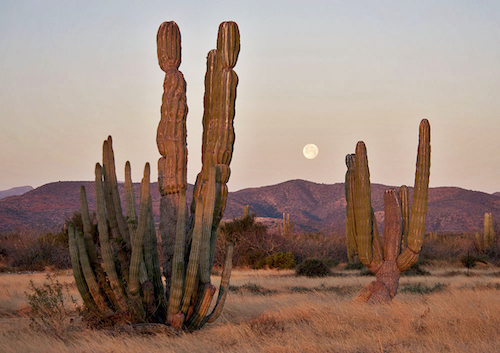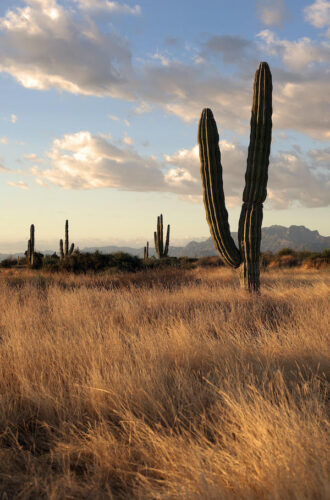
By Dave Kelly, author of “Hiking Loreto”
Desert Hiking is quite different from hiking through other terrains and offers truly unique rewards. If you aren’t familiar with it, you may think of the desert as hot, dry, harsh, hazardous and not very appealing. To the contrary, desert hiking can be extremely rewarding and pleasurable. The desert isn’t always hot, and although you certainly may want to avoid the summer months, the winter offers great hiking temperatures. The desert terrain allows you to see for miles and therefore invites hiking even in areas without trails. Without trees, it is easier to manage crossing the desert keeping a distant destination in sight. Every area has been affected differently and carved by years of water, wind and ice erosion. The resulting variations in land formation include canyons, natural bridges, arches, windows, pinnacles, tufas, slot canyons, hoodoos, and sand dunes to name a few. You’ll find plenty of solitude in the vastness of the desert landscape, and desert hiking offers countless opportunities to gain vantage points for outstanding views.

For those of you new to this area and hiking in the desert, the best tip we can offer is to hire a local guide. You will be rewarded with a wealth of information, you won’t spend lots of time getting lost and you’ll be helping the local economy. Most of the trails here are “Wilderness Trails”, meaning there are no trail signs, no painted blazes, just an occasional cairn, that may or may not be marking the correct path. Be aware of landmarks along your hike so you can find your way back. Spending a night out in the desert unprepared can be an unpleasant adventure, as nighttime temperatures can be quite cold. Most vegetation in the desert has thorns or cactus barbs attached, but because the vegetation is also sparse (except for in the washes) it’s easily visible and usually avoidable even when you’re hiking off-trail.
Wear loose-fitting layers of natural-fiber clothing to help reduce your chances of becoming dehydrated. Sturdy shoes are a necessity in the desert. They give your feet support, traction and protection from cactus spines. Long pants and a long sleeve shirt will help too. A hat, sunglasses, kerchief and lots of sunscreen will help keep the powerful rays of the sun at bay. Temperatures can drop dramatically in the desert at night, and even if you don’t plan to spend the night, you should bring along a warm sweater or jacket just in case you get lost. Always pack matches, a flashlight, a pocket knife and a well-stocked first-aid kit, and be sure to include a good pair of tweezers in case you need to pick cactus needles out of your skin.
Take plenty of fresh water with you. Drink at least 2-3 liters of water a day when you are hiking in the desert, and turn back when your water supply is half gone. Remember, there is very limited cell phone service and there is no organized rescue group. Take your day out seriously, be prepared and be smart.
For more hiking information about hiking in the Loreto BCS area, the Hiking Loreto guidebook is available in Loreto at the Cabello Blanco Bookstore on Hidalgo, Gavilon, across from El Pescador market, Pacos Place on the Plaza, The Blanket Factory west of the Mission, The Deli on Benito Juarez and at Pedro’s Place, Loreto Bay. Also online at HikingLoreto.com
